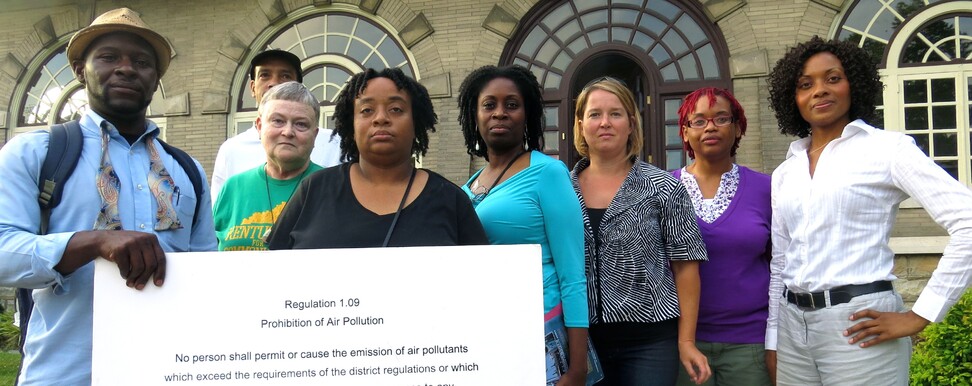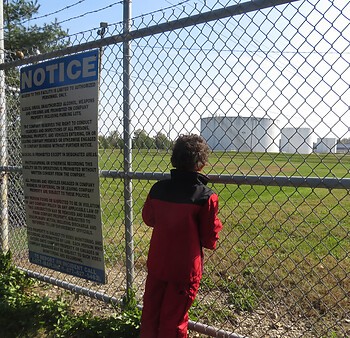
About EJHA
The Louisville Charter for Safer Chemicals
|
|
More resources, including policy papers, guides and action opportunities are available at www.louisvillecharter.org!
The Environmental Justice Health Alliance for Chemical Policy Reform (EJHA) utilizes the Louisville Charter for Safer Chemicals to guide policy, regulation, and rulemaking for industry and government agencies as it pertains to Chemical Security. Chemical Security is a term that describes community and worker protection from chemicals that are often stored near where people are living, or that are transported through residential areas, posing a hazard to families, children, workers and the environment.
Every day, millions of people live and work in the shadow of 12,440 high-risk chemical facilities that store and use highly hazardous chemicals with the potential to kill or injure thousands of workers and community residents. Eighty-nine of these facilities put more than one million people at risk.
The people who live in communities surrounding these facilities are at greater risk than anyone except the workers in the plant in the event of an explosion or catastrophic release of a poison gas. These communities are more likely to be low-income communities and communities of color.
Chemical manufacturing plants, chemical storage facilities (such as those used for wastewater treatment plants or manufacturing), train yards and port facilities are typical areas where chemical security is an issue.
Corporations tend to build these chemical storage areas in low income communities of color, whose families are disproportionately and adversely affected by chemical exposures. EJHA promotes safer chemicals and processes that exist as the alternatives to the toxic chemicals currently used by facilities and industries located in environmental justice communities in the United States and throughout the world.
The Louisville Charter for Safer Chemicals provides guidance for policy making that is rooted in justice for communities and workers.
The Louisville Charter for Safer Chemicals
A Platform for Creating a Safe and Healthy Environment through Innovation
Fundamental reform is possible. We can protect children, workers, communities, and the environment. We can shift market and government actions to phase out fossil fuels and the most dangerous chemicals. We can spur the economy by developing safer alternatives. By investing in safer chemicals, we will protect people’s health and create healthy, sustainable jobs. One of the first steps to creating a safe and healthy environment is new action in our nation's chemical management policies and addressing the adverse role of current chemical production and practices in new climate policies.
To achieve our vision, any reform must:
1. Address the Significant Impacts of Chemical Production and Use on Climate Change. Significantly reduce, replace and/or eliminate the use of fossil fuels and production of greenhouse gases in every part of the chemical production industry including: (1) the use of fossil fuels as feedstock for products, such as plastics, pesticides, and and use of chemicals as feedstock for additives in fossil fuels; (2) the massive use of fossil fuels for energy production to manufacture chemicals; and (3) the production of chemicals that are significant greenhouse gases on their own, such as fluorinated gases that contribute to and exacerbate climate change.
2. Prevent Disproportionate Exposures and Hazards, and Reduce Cumulative Impacts on Environmental Justice Communities. Adopt policies and practices that remedy the disproportionate chemical hazards and exposures faced by communities of color, Tribes and Native/Indigenous communities, and low-income communities, and that address combined burdens of multiple pollutants, multiple sources, and accumulation over time with vulnerabilities that exist in a community. Break down and end discriminatory practices and policies that result in disproportionate and cumulative impacts in these communities. To this end, grassroots, fenceline and environmental justice communities must be at the table when developing and advancing chemical policies at all levels.
3. Require Safer Substitutes and Solutions for a Non-Toxic Economy. Eliminate hazardous chemical use, production, and emissions and replace them with demonstrably safer alternatives by: (1) redesigning chemical products and systems; (2) altering production processes; (3) substituting with safer chemicals; (4) limiting output to produce chemicals shown to be safe throughout their lifecycle and necessary; and (5) rewarding innovation. Green Chemistry Principles need to shape innovation in a revamped chemical sector that transitions from petroleum-based chemical feedstock production to bio-based and low-hazard platform chemicals. Achieving a non-toxic economy requires political will and a shift in power that puts the health of people and the planet above the entrenched political lobbying of the chemical industry. It also requires a just transition for workers in the impacted sectors.
4. Use Scientific Data to Support Health-Protective Policies and Practices. Require chemical manufacturers, importers, and businesses to provide credible independent and verifiable scientific data for all new petrochemicals and energy-related pollutants to inform principles, policies, and practices to effectively protect human health, especially vulnerable populations, and the environment. When appropriate, use scientific data, applied to chemical classes rather than one chemical at a time – including epidemiology, whole animal studies, cellular and mechanistic information, and physical chemical hazard traits - to identify potential hazards for early actions and regulatory decisions that expand health protections for workers, families, and communities.
5. Take Urgent Action to Stop Production and Recover Chemicals that are Unsafe and/or Accumulate in the Environment and People. Phase-out, ban and recover chemicals that present immediate threats to safety due to flammability or potential to explode; do not break down or are slow to degrade (persistent); accumulate in people and the food chain (bioaccumulative); are highly mobile in the environment and threaten drinking water supplies; and/or contribute to climate change. Chemicals and classes of chemicals that have one or more of these properties warrant immediate action.
6. Act with Foresight to Protect Health and Prevent Pollution. Act to prevent harm when credible evidence shows that a substance or class of substances is potentially hazardous and/or harm is occurring or is likely to occur, even when information is incomplete regarding the exact nature and magnitude of the harm, in order to safeguard communities, workers, consumers, and others from exposure. Limit or stop the manufacturing and use of chemicals in the market where scientific data shows harm to human health or the environment.
7. Take Immediate Action to Protect, Restore and Strengthen Communities. Ensure that when communities or workers are exposed to levels of chemicals that pose an immediate health or safety hazard, immediate action is taken to eliminate these exposures or risks. Communities and workers that have been harmed by chemical exposures, or that face ongoing legacy exposures, must be fully restored and supported in their growth beyond restoration.
8. Ensure the Public and Workers Fully Have the Right-To-Know, Participate and Decide. Provide meaningful involvement for the public and workers in the decisions that impact their health because of the potential harm from toxic chemicals. Remove barriers to public information and participation. Disclose all the chemicals in products, make the names and quantities of chemicals produced, used, released, and exported publicly available and provide public/worker access to corporate and government decision-making about chemical hazards.
9. Incentivize Responsible Business & Safer Chemicals. Businesses that act responsibly by providing 3 party-verified safer and healthier chemicals, materials products and services should be prioritized and incentivized. Subsidies should be curtailed for companies that continue to pollute and produce chemicals that are harmful to human health and the environment. The harmful business practices, which in turn costs incredible damage to local, state and national economies, should become the financial responsibility of those companies.
10. Build an Equitable and Health-Based Sustainable Economy. Build an equitable values-based economy that transitions us from short-term profit at all cost to one which both advances a non-toxic economy and centers this transition on the needs of small and medium enterprises, advances local economies, supports communities of color, Tribes and Native/Indigenous communities, and low-income community-owned businesses, supports new corporate forms inclusive of worker ownership, livable wages and ensures a just workplace.

 A child playing in Louisville's Chickasaw Park looks onto a neighboring industrial facility. Photo Credit: Elizabeth Crowe
A child playing in Louisville's Chickasaw Park looks onto a neighboring industrial facility. Photo Credit: Elizabeth Crowe